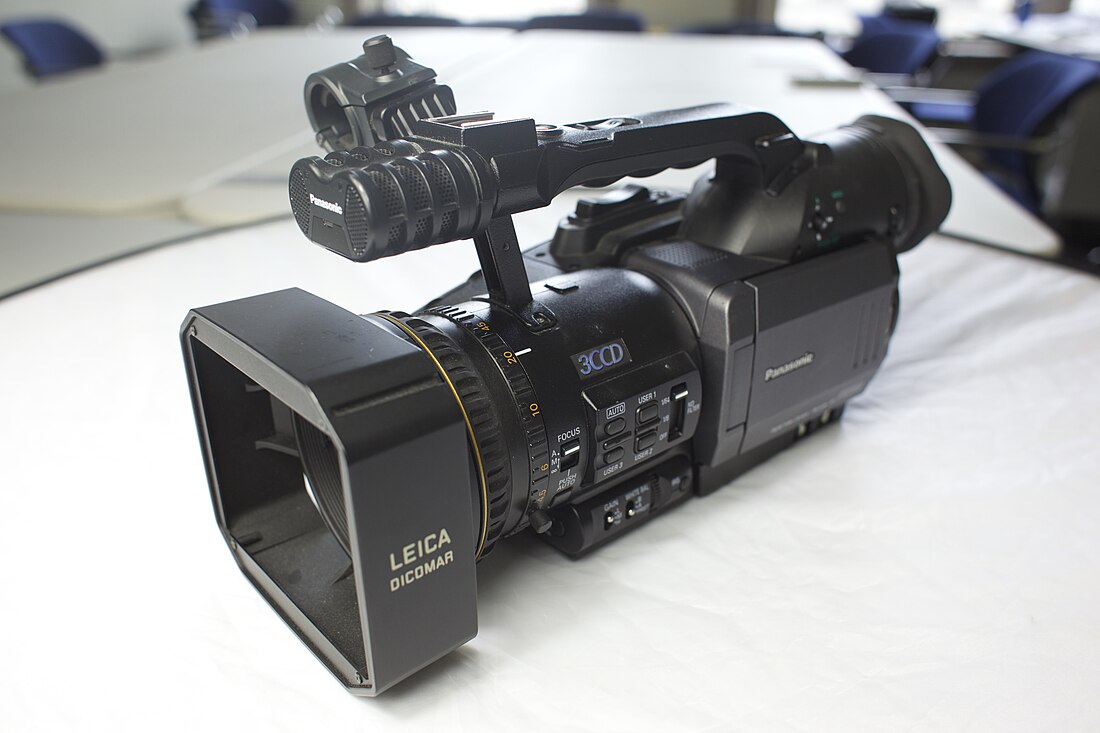Panasonic AG-DVX100
Digital video camcorder From Wikipedia, the free encyclopedia
The Panasonic AG-DVX100 is a video camera released on October 13, 2002 by Panasonic. It was the first consumer 60-hertz digital camcorder to offer video recording at 24 frames per second (progressive scanning at 24 frames per second) onto MiniDV tape. This feature, which replicated the cinematic frame rate of traditional film, made the camera particularly popular among independent filmmakers seeking a film-like aesthetic on a digital budget..[2][3][4]
This article has multiple issues. Please help improve it or discuss these issues on the talk page. (Learn how and when to remove these messages)
|

The camera's last update occurred in 2005 with the release of the Panasonic AG-DVX100B(E). It primarily recorded video onto cassette tapes. Later, third-party developers introduced modifications that enabled it to stream footage directly to a connected laptop or desktop computer. Reel Stream, one of the companies behind these modifications, has since ceased operations.[5][6]
In the Chinese market, the series was branded as AG-DVC180/A/B, and was identical to the European PAL model AG-DVC180E.
Technical specs
Summarize
Perspective
The Panasonic AG-DVX100 series featured cameras designed to record video at 24p, similar to the frame rate of traditional film cameras. This 24p format, using progressive scan, avoids the artifacts associated with interlaced formats, enhancing its appeal for independent and lower-budget motion picture production.[7]
The original AG-DVX100 model recorded in a 4:3 aspect ratio. The original camera received two revisions. The first (A) revision introduced widescreen recording capabilities. The second (B) revision corrected an issue allowing proper monitoring of the 16:9 aspect ratio. All revisions were equipped with charged-coupled device (CCD) sensors with a native 4:3 aspect ratio.
The Panasonic AG-DVX100 employed a 3-CCD imaging system that separates light into red, green, and blue channels, each processed by its own CCD sensor. Compared to single-chip systems, the CCD approach improves the separation of color channels to support accurate image reproduction. The camera featured 410,000-pixel sensors, with approximately 380,000 effective pixels, aligning with standard specifications for professional cameras of its era. This setup produced video quality consistent with the technical standards of certain filmmaking and broadcast applications of its era.[8]
The camera recorded 24p video using a "telecined" method with 2:3 pulldown for 24P and 2:3:3:2 pulldown for 24PA. It also supported 30p video in progressive segmented frame (PSF) format (25p in PAL) and standard interlaced video at 60i (50i PAL), all stored on MiniDV tape. The DVX100 included "Cine-Gamma" functionality, simulating the gamma curve characteristic of film.
The camera included two XLR audio inputs for professional-grade sound, a 4-pin FireWire port (IEEE 1394) for digital video transfer, and both S-Video and RCA input or output ports for analog connectivity. It offered manual and servo zoom options, along with a secondary zoom control and record button on the handle for low-angle recording.[9]
The camera featured two built-in neutral density filters, labelled as ND1 and ND2, with ND1 reducing the light by a factor of 1/8 (equivalent to 3 f-stops) and ND2 reducing light by a factor of 1/64 (equivalent to 6 f-stops). This feature offered additional control over exposure settings in varying lighting conditions and allowed for motion blur effects. The neutral density filters could prevent overexposure while also maintaining a fixed shutter speed.
Use in film and television
The AG-DVX100 was used in several independent film and television projects, including films screened at the Sundance-screened November, the documentary Murderball,[10] Iraq in Fragments,[11] seasons 1–5 of the TV show It's Always Sunny In Philadelphia[12],The Puffy Chair and The Man From Earth,[13] as well as episodes of The Tink's VidDream Television. A model equipped with onboard lights was used to shoot the documentary film Ghost Adventures.[14]
References
Wikiwand - on
Seamless Wikipedia browsing. On steroids.
